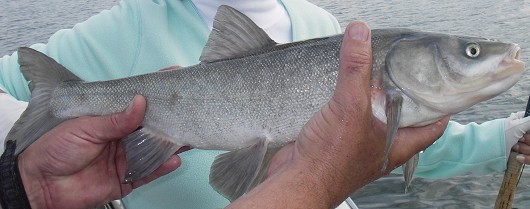Sacramento Blackfish
-
Scientific NameOrthodon microlepidotus
-
NativeNative Species
-
Identification
 Sacramento blackfish, caught in the San Joaquin river near Stockton on 11/11/08. Photo by Steve Reem.
Sacramento blackfish, caught in the San Joaquin river near Stockton on 11/11/08. Photo by Steve Reem.- Size rarely exceeds 50 cm SL and 1.5 kg, male/female growth may differ
- Round elongated body, long narrow caudal peduncle, tiny scales: (90-105) laterally
- Cone shaped head with flat sloping forehead, small eyes
- Terminal mouth with thin lips, slightly upturned
- Dorsal fin origin in front of pelvic fin origin
- Adults light to dark gray, with olive sheen, progressively darker with size
- Young fish silver in color
- Males may grow breeding tubercles and develop darker coloration during breeding season
- Fin rays: dorsal 9-11, anal 9-11, pelvic 10
-
Life History
Sacramento blackfish are native to the Sacramento and San Joaquin drainages as well as to Clear Lake. These fish however are found in other various streams and reservoirs in California, and have extended into parts of Nevada. Sacramento blackfish prefer warm turbid waters in small to large streams, and often share habitat with an array of non-natives. Sacramento blackfish prefer water temperatures in the range of 22-28°C. They have shown a great ability to adapt to extreme environments including water temperatures exceeding 30°C and salinities in excess of 9 ppt. Blackfish are typically suspension feeders with a diet of planktonic algae and zooplankton, including copepods, insect larvae, rotifers, cladocerans, and detritus. Young fish tend to feed in the water column or stream bottom on zooplankton and insects. Juvenile fish may school along lake shores where prey is abundant. As Sacramento blackfish grow they become increasingly reliant upon pumping suspended material into their mouths, using their gill rakers as a filter, and trapping food in mucous in the roof of their mouth. Adults can live on a diet of primarily organic matter and algae. Pond and lake inhabitants can feed on diatoms, algae, and zooplankton, or may pick up organic matter and small invertebrates from the bottom. Sacramento blackfish may become sexually mature in their first, second, third, or fourth years, depending upon their growth rate. Males tend to reach sexual maturity before the females, and the production of eggs in females seems to be directly related to body size. A female of 171 mm FL may produce 14,700 eggs, while a female of 466 mm FL can produce some 346,500 eggs. Spawning generally occurs in spring but may happen anytime between March and July when water temperatures are in the range of 12-24°C. Spawning beds are usually found in areas of thick vegetation and shallow water. The eggs will cling to the local substrate till the larvae emerge and begin foraging in the same region.
-
Links to Other ResearchN / A
-
Watershed
-
Alisal-Elkhorn Sloughs Watershed
-
Coyote Watershed
-
Lower American Watershed
-
Lower Bear Watershed
-
Lower Butte
-
Lower Cache Watershed
-
Lower Calaveras-Mormon Slough Watershed
-
Lower Cosumnes-Lower Mokelumne Watershed
-
Lower Cottonwood Watershed
-
Lower Feather Watershed
-
Lower Pit Watershed
-
Lower Sacramento Watershed
-
Lower Yuba Watershed
-
McCloud Watershed
-
Middle Kern-Upper Tehachapi-Grapevine Watershed
-
Middle San Joaquin-Lower Chowchilla Watershed
-
Middle San Joaquin-Lower Merced-Lower Stanislaus Watershed
-
Mill Watershed
-
North Fork American Watershed
-
Pajaro Watershed
-
Panoche-San Luis Reservoir Watershed
-
Russian Watershed
-
Sacramento Headwaters Watershed
-
Sacramento-Lower Cow-Lower Clear Watershed
-
Sacramento-Lower Thomes Watershed
-
Sacramento-Stone Corral Watershed
-
Sacramento-Upper Clear Watershed
-
Salinas Watershed
-
San Francisco Bay Watershed
-
San Joaquin Delta Watershed
-
San Pablo Bay Watershed
-
South Fork American Watershed
-
Suisun Bay Watershed
-
Tulare-Buena Vista Lakes Watershed
-
Upper Bear Watershed
-
Upper Cache Watershed
-
Upper Coon-Upper Auburn Watershed
-
Upper Cosumnes Watershed
-
Upper Cow-Battle Watershed
-
Upper Deer-Upper White Watershed
-
Upper Los Gatos-Avenal Watershed
-
Upper Poso Watershed
-
Upper Putah Watershed
-
Upper Stanislaus Watershed
-
Upper Stony Watershed
-
Upper Tuolumne Watershed
-
Upper Yuba Watershed
-
Please note, watersheds are at the USGS 8-digit Hydrologic Unit Code (HUC) scale, so they often include a lot of sub-watersheds. If a species occurs in any sub-watershed within the HUC, the species appears within the HUC. Link to an EPA page that shows HUCs.
